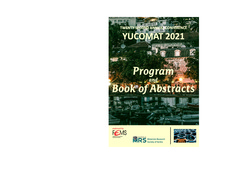Приказ основних података о документу
ZnO nanoparticles with optimized surface-to-bulk defect ratio for potential biomedical application
| dc.creator | Marković, Smilja | |
| dc.creator | Stanković, Ana | |
| dc.creator | Drvenica, Ivana | |
| dc.creator | Ristić, B. | |
| dc.creator | Škapin, Srečo Davor | |
| dc.date.accessioned | 2021-11-16T13:45:16Z | |
| dc.date.available | 2021-11-16T13:45:16Z | |
| dc.date.issued | 2021 | |
| dc.identifier.uri | https://dais.sanu.ac.rs/123456789/12094 | |
| dc.description.abstract | Due to tunable opto-electronic properties ZnO-based nanoparticles (ZnONPs) have been used for application in electronics, optoelectronics, photo(electro)catalysis, etc. Besides, as bio-inert, ZnONPs have a great potential in medicine for biosensing, bioimaging, drug and gene delivery, implants or as antimicrobial and anticancer agents. One of suggested governing mechanism of the biological activities of ZnONPs is based on the formation of reactive oxygen species (ROS). Actually, when ZnONP absorb photon with energy equal or greater than its band gap, electrons (e−) are excited from the valence band (VB) to the conduction band (CB) leaving the holes (h+) in VB. In following, the photogenerated h+ and e− migrate from bulk to surface. The photogenerated h+ at the VB react with water molecules adsorbed at the particle surface to produce hydroxyl radicals (OH•), while e− in CB react with oxygen molecules generating anionic superoxide radicals (O2−•). Radicals can be transformed in highly reactive hydroxyl radicals and so on. Derivatives of this active oxygen can damage the bacterial/tumor cells. However, in sufficiency ROS can damage normal cells as well. Thus, an understanding of ZnONPs crystal structure-activity relationship is crucial for the design of materials safe for application in treating diseases like cancer. In this study we established correlation between the surface-to-bulk defects ratio in ZnONPs and ROS formation. To vary surface-to-bulk defects ratio, series of ZnONP samples were synthesized by microwave processing of precipitate in the presence of a different amount (5, 10 and 20 wt.%) of surfactants, precisely, CTAB and citric acid. The particles crystallinity and phase purity were investigated by X-ray diffraction, Raman and FTIR spectroscopy. The particles morphology and texture properties were observed with FE–SEM and BET, respectively. The optical properties were studied using UV–Vis DRS and PL spectroscopy. ZnONP samples with different surface-to-bulk defect ratio were examined on ROS formation. Surface-to-bulk defect ratio in ZnONP was correlated with ROS formation, besides; their influence on cytotoxicity to normal and cancerous cells was comprehended. | sr |
| dc.language.iso | en | sr |
| dc.publisher | Belgrade : Materials Research Society of Serbia | sr |
| dc.relation | info:eu-repo/grantAgreement/MESTD/inst-2020/200175/RS// | sr |
| dc.relation | info:eu-repo/grantAgreement/MESTD/inst-2020/200015/RS// | sr |
| dc.rights | openAccess | sr |
| dc.rights.uri | https://creativecommons.org/licenses/by/4.0/ | |
| dc.source | Programme and the Book of abstracts / Twenty-second Annual Conference YUCOMAT 2021 Herceg Novi, Montenegro, August 30 - September 3, 2021 | sr |
| dc.subject | ZnO | sr |
| dc.subject | nanoparticles | sr |
| dc.subject | defect ratio | sr |
| dc.subject | ROS formation | sr |
| dc.subject | microwave processing | sr |
| dc.title | ZnO nanoparticles with optimized surface-to-bulk defect ratio for potential biomedical application | sr |
| dc.type | conferenceObject | sr |
| dc.rights.license | BY | sr |
| dc.citation.spage | 51 | |
| dc.citation.epage | 51 | |
| dc.type.version | publishedVersion | sr |
| dc.identifier.fulltext | https://dais.sanu.ac.rs/bitstream/id/48156/Markovic_YUCOMAT-2021.pdf | |
| dc.identifier.rcub | https://hdl.handle.net/21.15107/rcub_dais_12094 |

